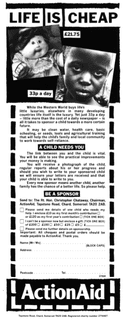Fundraising is child's play
Few of us (in the UK) will have not picked up on Charlie Simpson, the 7 year-old boy who raised over £200,000 to help people in Haiti by doing a sponsored cycle round his local park.
But Charlie isn't the only child from whom fundraisers can learn.
Markita Andrews was an American Girl Scout (Girl Guides in the UK), who sold over $80,000 worth of cookies as part of a fundraising drive.
Markita had a number of tips as why she was so successful.
First off she maximised her impact by concentrating on being where she could find most customers. She would go from door to door, but she preferred the lobbies of apartment blocks where she would sell to people as they were coming home from work.
But more importantly, she framed her pitch so that customers saw the purchase as a trivial expense. She explained this when she was interviewed on the Johnny Carson show...
"I just went to everyone's house and said 'Can I have a $30,000 donation for the Girl Scouts?' When they said no, I asked would they at least buy a box of Girl Scout Cookies?"
Neuromarketing sees this approach as being similar to commercial sticker price framing. This technique compares the original price on a price tag (usually with a great big red cross through it) next to the sale price, emphasising what a great deal the customer is getting.
 This is a technique that can be used by charities to generate donations in other ways than through the sale of cookies. When I was at ActionAid, we regularly compared the price of sponsorship to what else it might buy. One of the most successful ads compared the cost of sponsorship to the price someone might pay for a child's toy.
This is a technique that can be used by charities to generate donations in other ways than through the sale of cookies. When I was at ActionAid, we regularly compared the price of sponsorship to what else it might buy. One of the most successful ads compared the cost of sponsorship to the price someone might pay for a child's toy.
We would also break that cost down further in the body copy, demonstrating that £10 a month worked out at just 33 pence a day.
I've written before about the YMCA £5,000 pack that I ran for years in the 1990s. This pack used to generate a large number of £5,000 gifts, but within it were lower value prompts. These 'drop asks' were a powerful route to engage less affluent donors.
Asking for £5,000 didn't necessarily put people off. But using it, placed lower value gifts into context making them seem far more manageable.
It is one of the techniques that I still recommend today. If, for example, your current banker pack asks for £15, why not try a small test where you dramatically raise the primary donation request, but continue to offer the £15 option within the body of the pack.
It can't be applied without careful thought as it won't work for all packs, all offers or all lists, but it can be a very powerful tool.
Tags In
The Essentials

Crack the Code to Regular Giving: Insights, Strategies, and a Special Giveaway!

‘Tis Halloween. Keep to the light and beware the Four Fundraisers of the Apocalypse!

Why do people give? The Donor Participation Project with Louis Diez.

A guide to fundraising on the back of a postcard

What does the latest research tell us about the state of fundraising?





